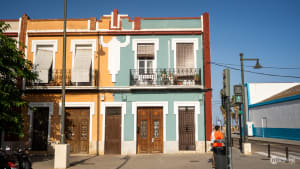
Mascletás
A growing tempo, an unrelenting rhythm, and a final thunder that shakes the whole city. This is the Fallas’ daily reminder.
Mascletàs in a nutshell…
The Mascletà is a daily pyrotechnic spectacle during Fallas, where rhythmic firecracker explosions shake the city with sound and vibration. Rather than a visual fireworks display, the focus is on noise, intensity, and tempo, culminating in a deafening finale known as the “earthquake”.
Location: The largest Mascletà takes place in Plaza del Ayuntamiento, but many smaller displays happen in neighborhoods across Valencia.
Time: Held daily at 2:00 PM from March 1 to 19, plus a special Crida Mascletà on the last Sunday of February. Some nighttime Mascletàs are scheduled in different locations.
Entry: Free to attend, but expect dense crowds. Arrive early for a good spot.
A Mascletà is an extraordinarily loud firecracker show. And under Fallas, there are several of these in Valencia, where they are highly appreciated and much awaited. In its most popular form, a Mascletà is a daytime event (although there are a few nighttime editions).
This means that the display is not about colours or shapes, it’s about sound and rhythm above all. A large number of powerful firecrackers called masclets - hence the name of the event - are fired consecutively with the aim of producing rhythmic noises.
The Mascletà starts softly, and gradually the volume of the sounds increases. Explosives chase one another in a cadence that grows in intensity at every chime of the clock. Until finally, there is no respite in the frenzied rhythm, and the beat explodes in a roaring climax.

This final explosion, where numerous explosives go off at the same time, is so powerful that it makes the whole city shake. If you’re lucky enough to witness this in person, you will feel the vibrations in your bones and the sulfuric smell of gunpowder all around you.
The Mascletá is most well-known for its role in Fallas. During the festival, a huge Mascletà takes place daily in Plaza del Ayuntamiento. However, these are not the only Mascletàs in Valencia. In fact, many neighbourhoods set off their own Mascletàs (sometimes even at night) during Fallas. The display is also common in other celebratory events and occasions.
The Techniques and Artists
The Mascletà is not just about making the display as loud as possible - although it is also that. It is also about creating rhythm, making the ground under the spectators’ feet and the stone of the buildings around them vibrate. It’s about trying to create something new and unexpected out of gunpowder.
The Firecrackers
The fireworks used are called masclets, and have a higher explosive capacity than regular firecrackers. They are joined by a fuse and generally placed on the ground or hung about 2 metres (6 feet 5 inches) high to poles and wires. When one end of the fuse is lit up, the masclets start going off, one after the other, creating a thunderous rhythm that usually ends in a sound so loud it’s referred to as the earthquake.

The Mestre de Traca
The key figure in a Mascletà is the mestre de traca, the master pyrotechnician responsible for carrying out the display. They are the ones to orchestrate the timing and explosion of each firecracker so that it creates a harmonious composition. And massive innovations, like electronic, long-distance controllers, have been brought forward with time, allowing for more complexity and sophistication in the delivery of the show.
History
Like many other Fallas traditions, the origins of the Mascletà are surely ancient but murky. What can be said without a doubt, is that pyrotechnics are very dear to the Valencian people. The region is the land of fireworks and firecrackers.
There is no occasion, no festival, no celebration, or even simple family gathering where firecrackers are not set off. And the guidelines generally follow the principle that the noisier, the better. In fact, it isn’t unusual to hear loud firecracker displays go off during weddings, baptisms, or other religious events.
18th century - Origins
Some trace the origins of this tradition back to the tracas of Almansa (a town near Valencia).
20th century - Correfocs
Firecrackers were mounted on wires that ran the streets of Valencia, ending in today’s Plaza del Ayuntamiento. The public - mostly men, called correfocs - ran and danced under the traca, accompanying the fire and the sequence of explosions. This happened during the Semana Fallera, between the 13th and the 19th of March.
1945 - Plaza del Ayuntamiento
On 11th March a form of Mascletà more similar to what we know today was established. The display stopped being a moving event, and instead, it centred around a fixed point, in Plaza del Ayuntamiento.
1986 - First Monday
The Mascletà, now grown in popularity and much appreciated by the public, began being held daily from the first Monday in March.
1988 - 1st March
From here onwards, the Mascletàs have been held from the 1st of March until the 19th.
End of the 20th century - Technical progress
The Mascletà continued to evolve in complexity and precision, especially thanks to the progress in the techniques and devices used - increasingly more electronic.
2008 - Largest Mascletà
The gunpowder limit went up to 240 kg (about 530 pounds), the biggest Mascletà to date.
2009 - Gunpowder limit
For safety reasons, the gunpowder limit has been set to 120 kg (about 265 pounds) per Mascletà - still a deafening quantity.
What Happens in a Mascletá
Mascletàs under Fallas can be daytime or nighttime events. In any case, a typical Mascletà is usually structured in four parts:
- The start of the show, which is characterised by both visual and sound effects.
- The central part, when the intensity, speed, and volume of the firecrackers gradually increase.
- The Terratrèmol (earthquake), when a large number of powerful masclets go off in unison, creating an effect so intense that it resembles an earthquake.
- The air show, with which the Mascletà is concluded. Visible and colourful fireworks are set off into the sky.
Mascletàs Diurnas
Mascletàs diurnas happen daily under Fallas ( from the 1st to the 19th of March ) at 2:00 pm.
The best-known and biggest one is in Plaza del Ayuntamiento. Even though this is a daily event, it is long-anticipated every day, and the presence of the Fallera Mayor is required to start this earth-shaking exhibition. The event is so revered that for the occasion, the square is often referred to as the Catedral de la Polvora (Gunpowder Cathedral).
The event is not just a show but also a competition of sorts among the various pyrotechnic groups, who try to outperform each other with their spectacular displays. The duration is generally just under 10 minutes, depending on the amount of gunpowder used. The audience acts as an informal judge, expressing its appreciation for the display with thunderous applause.

Smaller Mascletàs also take place around the same time in various committees’ neighbourhoods. They are normally not as formalised, so the timetable might not be as strict. Another special Mascletà is the first of the year, which takes place on the day of the Crida (the last Sunday in February).
Mascletàs Nocturnas
Another type of Mascletà is the nighttime kind. These displays are not as frequent as the daytime ones and take place in different neighbourhoods every year. Their dates are normally announced on the official programme.
As opposed to the daytime Mascletàs, these nocturnal ones allow for more colourful effects and better visibility, so much so that they are often referred to as Mascletà de colores (Mascletà of colours).
Our Tips and Insights
- Always make sure you keep a safe distance from the set off-site. An exploding firecracker, no matter how small, can cause serious burns if you’re too close to it.
- Before choosing your spot to watch the Mascletà, check the direction of the wind. You don’t want the smoke to be blowing in your face.
- If you want to see a Mascletà in real life but you want to avoid the more deafening sounds, you can go by the fountain in Plaza del Ayuntamiento. That’s the place where the Mascletà generally starts - remember it starts low to build up in volume. This way, when the display is at its maximum volume, you will be far away from the explosions.
- If instead, you don’t mind the noise and want to be at the loudest spot, you should go to the end of Plaza del Ayuntamiento where the Correos building is. That is where the Mascletà usually ends, and as you know, the last part of the display is the loudest.
- If you want a view of the whole event, the best spot is surely a balcony in Plaza del Ayuntamiento. Luckily, a lot of them are up for rent to see the Mascletà.
- Whatever your chosen spot, try to get there early because a crowd start forming as early as 1:30 pm. The closer 2:00 pm gets, the harder it is to move from one place to the other due to the large crowd.
- During the weekend, the crowd is even bigger, so be warned.
- If the noise gets too much for you, open your mouth a little! This is a Valencian trick to make the noise riverberate less in your head.
- The closer you are to the explosions, the more likely it is that by the end of the display you’ll be covered in coloured paper scraps from the firecracker paper shells.
- If you think that the Mascletà in Plaza del Ayuntamiento is a bit much for you, you can try the smaller Mascletàs in the different Fallas committees. There are fewer people, they are easier to see, and way less loud. Also, they are generally timed so that you can see more than one Mascletà by moving across different neighbourhoods.
Frequently Asked Questions
Here you can find quick answers to all of your questions. Linked, you’ll find the articles or the sections of the articles that can give you more detailed information.
-
A Mascletà is a pyrotechnic display whose purpose is to produce as much noise as possible in a rhythmic manner. Their point is to celebrate the Fallas festival.
-
Mascletàs can be diurnas (daytime) or nocturnas (nighttime). Out of all of them, the most famous is the Mascletà diurna which takes place in Plaza del Ayuntamiento.
-
The most famous Mascletà (diurna) takes place in Plaza del Ayuntamiento. However, there also are smaller mascletàs celebrated in the different committees’ neighbourhoods.
The Mascletàs nocturnas are celebrated each year in a different area.
-
The Mescaletàs diurnas are celebrated every day at 2:00 pm between the 1st and the 19th of March, plus as a special Mascletà at 2:00 pm on the day of the Crida.
The Mascletàs nocturnas on the other hand, usually happen on selected dates, around 9:00 pm or 11:00 pm.
-
The word Mascletà, used to refer to a daily pyrotechnic display, comes from the name of the firecracker used, a masclet.
-
Normally, a Mascletà is quite short, lasting between 5 and 10 minutes.
-
Yes, extremely. It is probably one of the loudest events in the whole Fallas, and it happens daily, so be aware.
-
Quite a few. The Mescaletà is celebrated every day between the 1st and the 19th of March, as well as a few Mascletàs nocturnas and a special Mascletà on the day of the Crida.
-
The point of the Mascletà is simply festive, it is so that the city can celebrate Fallas.
-
If you want a view of the whole event, the best spot is surely a balcony in Plaza del Ayuntamiento.
If you’d like more tips to better enjoy the Mascletà, check out the dedicated section of this article.



















